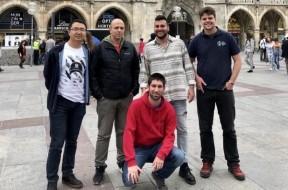The discovery by the University of Oviedo and CINN-CSIC (the Spanish National Research Council's Nanomaterials and Nanotechnology Research Centre) based in El Entrego, will enable progress on the development of compact photonic technologies, such as high-sensitivity biological sensors and information and communication technologies
Research staff from the University of Oviedo and CINN-CSIC (the Spanish National Research Council's Nanomaterials and Nanotechnology Research Centre) based in El Entrego, have discovered an effective method for controlling the frequency of light confined to the nanometre scale (ie about one hundred times smaller than the thickness of a human hair). The finding, published in the prestigious journal "Nature Materials", will allow progress in developing compact photonic technologies, such as high-sensitivity biological sensors and information and communication technologies at nanoscale.
So-called nanolight has undergone considerable development in recent years, thanks to the discovery of sheet-structured nanomaterials like graphene, boron nitride and molybdenum trioxide (referred to as van der Waals materials). The discovery by the University of Oviedo and CINN-CSIC contributes to solving one of the main drawbacks in the technological application of nanolight: namely, the fact that they can only exist in limited frequency ranges that are characteristic of each material. The Asturian researchers propose a novel method that enables this range of working frequencies of polaritons in van der Waals materials to be widely expanded. This consists of intercalating alkaline and alkaline earth atoms - such as sodium, calcium and lithium - into the laminar structure of the van der Waals vanadium pentaoxide material, thus enabling its atomic bonds, and consequently its optical properties, to be changed.
The study was carried out by the University of Oviedo's Quantum Nanooptics Group and CINN-CSIC (the Spanish National Research Council's Nanomaterials and Nanotechnology Research Centre) based in El Entrego, and led by researchers Pablo Alonso González and Javier Martín Sánchez, with the involvement of Javier Taboada Gutiérrez (first to sign up to the project), Gonzalo Álvarez Pérez and Jiahua Duan. National research groups (DIPC, CIC nanoGUNE and the University of the Basque Country) also took part, as did international research groups (Chinese Academy of Sciences, Case Western Reserve University in the US, Austrian Institute of Technology, Paris Materials Centre and University of Tokyo).
The article sets out in detail how the introduction of such alkaline and alkaline-earth atoms into the crystalline structure of vanadium pentaoxide is the way to achieve excitation of polaritons over wide frequency ranges without impairing their physical properties, given that polaritons travel similar distances and "live" for a period of time at the same order of magnitude in both the pristine vanadium pentaoxide and interlaid material.
"Considering the quantity of atoms with potential to be interlaid and the materials we have available, it is very possible that we will shortly be able to excite nanolight across the entire infrared spectrum", says Pablo Alonso González, distinguished researcher of the University of Oviedo's Physics Department.
"This discovery is very important from a technological point of view, as it enables the manufacture of devices for future information and communication technologies at nanoscale", adds Javier Martín Sánchez - Ramón y Cajal researcher - from the same department.
"This work is also highly relevant to other areas of knowledge - such as biology", comment Javier Taboada Gutiérrez and Gonzalo Álvarez Pérez, PhD students in the Quantum Nano-Optics Group. "The nanolight interacts strongly with molecules at certain infrared frequencies that we couldn't previously reach. We can now use this technology to detect many other molecules", they conclude.
Article details
"Broad spectral tuning of ultra-low-loss polaritons in a van der Waals crystal by intercalation"
Javier Taboada-Gutiérrez, Gonzalo Álvarez-Pérez, Jiahua Duan, Weiliang Ma, Kyle Crowley, Iván Prieto, Andrei Bylinkin, Marta Autore, Halyna Volkova, Kenta Kimura, Tsuyoshi Kimura, M.-H. Berger, Shaojuan Li, Qiaoliang Bao, Xuan P. A. Gao, Ion Errea, Alexey Y. Nikitin, Rainer Hillenbrand, Javier Martín-Sánchez and Pablo Alonso-González, Nature Materials, DOI: 10.1038/s41563-020-0665-0.
Partner institutions
University of Oviedo: www.uniovi.es
CINN-CSIC (the Spanish National Research Council's Nanomaterials and Nanotechnology Research Centre): https://cinn.es
CIC nanoGUNE: www.nanogune.eu/es/
Donostia International Physics Center (DIPC): http://dipc.ehu.es
Chinese Academy of Sciences: http://english.cas.cn
Case Western Reserve University: https://case.edu
Austrian Institute of Technology: https://ist.ac.at/en/home/
Paris Materials Centre: http://www.mat.mines-paristech.fr/Accueil/
University of Tokyo: https://www.u-tokyo.ac.jp/en/index.html
Thanks
- Spanish Department for the Economy, Industry and Competitiveness, the Government of Asturias' Clarín-Marie-Curie Cofund Programme (PA18-ACB17-29), Maria de Maeztu Programme of Excellence Units and the Spanish Government's Ramón y Cajal programme co-financed by the ESF (RYC2018-026196-I).
- European Research Council through the Starting Grant project 715496, "2DNANOPTICA".
- The Government of Asturias' "Severo Ochoa" aid programme for research and teaching training (PA-18-PF-BP17-126 and PA-20-PF-BP19-053)




